
Rail transport in New Zealand is an integral part of New Zealand's transport network, with a nationwide network of 4,375.5 km (2,718.8 mi) of track linking most major cities in the North and South Islands, connected by inter-island rail and road ferries. Rail transport in New Zealand has a particular focus on bulk freight exports and imports, with 19 million net tonnes moved by rail annually, with 99.5% of New Zealand's exports and imports being transported through the country's seaports.
The Southerner was a passenger express train in New Zealand's South Island between Christchurch and Invercargill along the South Island Main Trunk, that ran from 1970 to 2002. It was one of the premier passenger trains in New Zealand and its existence made Invercargill the southernmost passenger station in the world.

The NZR RM class Edison battery-electric railcar was a railcar that ran in Canterbury, New Zealand for eight years. It was built for New Zealand Railways (NZR) as a prototype for battery-electric railcars. While the railcar, classified "RM 6", was considered the first successful railcar in New Zealand, it was later destroyed in a fire, and battery-electric traction for railcars was not developed further in New Zealand. Two other classes of battery-electric locomotives were introduced about the same time as RM 6, the E class of 1922 and the EB class of 1925.
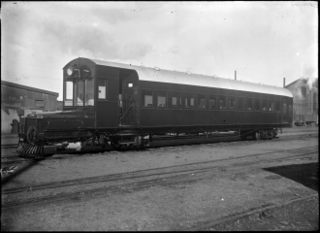
The NZR RM class Leyland petrol railcar was an experimental railcar built and trialled in New Zealand in 1925 by New Zealand Railways (NZR). It should not be confused with the two much smaller Leyland diesel railbuses of 1936.

The NZR RM class McEwan Pratt petrol rail motor was the first rail motor to run on New Zealand's national rail network, though it was never used in revenue service. It was built in 1912 at a time when the New Zealand Railways Department (NZR) was seeking alternative methods of providing rural passenger transportation. "Mixed" trains that carried both passengers and freight were typical on country branch lines as there was not sufficient traffic to justify a separate passenger train, but the schedule delays caused by loading and unloading freight during the journey made the mixed trains undesirable.
The New Zealand Railways Department, NZR or NZGR and often known as the "Railways", was a government department charged with owning and maintaining New Zealand's railway infrastructure and operating the railway system. The Department was created in 1880 and was corporatised on 1 April 1982 into the New Zealand Railways Corporation. Originally, railway construction and operation took place under the auspices of the former provincial governments and some private railways, before all of the provincial operations came under the central Public Works Department. The role of operating the rail network was subsequently separated from that of the network's construction. From 1895 to 1993 there was a responsible Minister, the Minister of Railways. He was often also the Minister of Public Works.
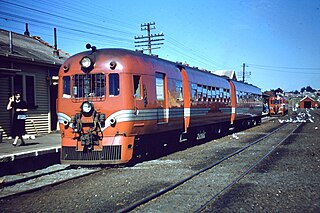
The NZR RM class 88-seaters were a class of railcar used in New Zealand. New Zealand Government Railways (NZR) classed them RM , the notation used for all railcars, numbering the 35 sets from RM100 to RM134. They were the most numerous railcars in NZR service, and were known unofficially as "Articulated", "Eighty Eights", "Twinsets", "Drewrys" or "Fiats". Their purchase and introduction saw the demise of steam-hauled provincial passenger trains and mixed trains.
The Railway Enthusiasts Society Incorporated is a New Zealand railway enthusiast society formed on 17 July 1958. RES formed the Glenbrook Vintage Railway (GVR) in 1968, with GVR now forming a separate charitable trust.
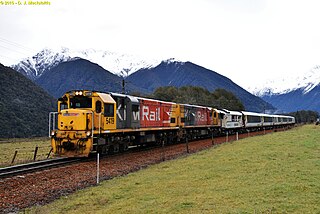
The TranzAlpine is a passenger train operated by The Great Journeys of New Zealand in the South Island of New Zealand over the Midland Line; often regarded to be one of the world's great train journeys for the scenery through which it passes. The journey is 223 kilometres (139 mi) one-way, taking almost five hours. There are 16 tunnels and four viaducts, with the Staircase Viaduct elevated as much as 75 metres (246 ft).
This is a list of jargon commonly used by railfans and railway employees in New Zealand.

The Stillwater Ngākawau Line (SNL), formerly the Stillwater–Westport Line (SWL) and the Ngakawau Branch, is a secondary main line, part of New Zealand's national rail network. It runs between Stillwater and Ngakawau via Westport on the West Coast of the South Island. It was one of the longest construction projects in New Zealand's history, with its first section opened in 1889 but the full line not completed until 1942.

The NZR RM class Wairarapa railcar was a class of railcars on New Zealand's national rail network. They entered service in 1936 and were classified RM like all other classes of railcars in New Zealand; they came to be known as the "Wairarapa" class as they were designed to operate over the famous Rimutaka Incline to the Wairarapa region on the Wairarapa Line. They also acquired the nickname of "tin hares" in New Zealand railfan jargon. The first two to be introduced re-used the numbers RM 4 and RM 5 that had previously been used by the withdrawn experimental Model T Ford railcars. The class consisted of six passenger railcars and one passenger-freight railcar. It is often described incorrectly as a class of six railcars.
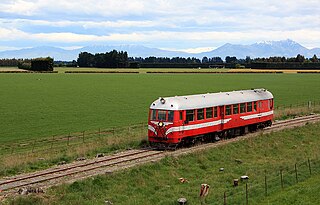
The NZR RM class Vulcan railcars were operated by the New Zealand Government Railways (NZR) in the South Island of New Zealand. All New Zealand railcars are classified as RM , and this class derived their nomenclature from the name of the manufacturer, the Vulcan Foundry of Britain.
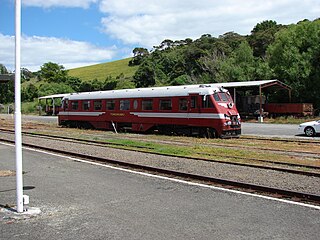
The NZR RM class Standard railcars were a class of railcar operated by the New Zealand Railways Department (NZR) in the North Island of New Zealand. Officially classified as RM like all other railcar classes in New Zealand, they acquired the designation of "Standard" to differentiate them from other railcar classes. They were introduced in 1938 and withdrawn in 1972.
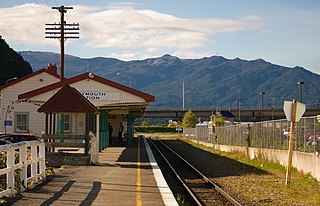
The Ross Branch, officially known as the Hokitika Line since 2011, and previously as the Hokitika Industrial Line, is a branch line railway that forms part of New Zealand's national rail network. It is located in the Westland District of the South Island's West Coast region and opened to Hokitika in 1893. A further extension to Ross operated from 1909 until 1980.
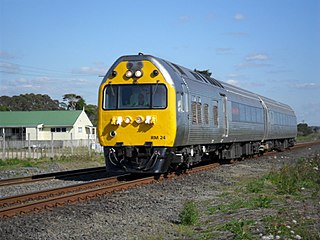
The RM class was the classification used by the New Zealand Railways Department (NZR) and its successors gave to most railcars and railbuses that have operated on New Zealand's national rail network. "RM" stands for Rail Motor. As many types of railcars are operated, class names have been given to each railcar type to differentiate them from others.

The NZR RM class Sentinel-Cammell was a steam-powered railcar operated by the New Zealand Railways Department (NZR). It was the only one of its type to operate in New Zealand, and one of only two steam railcars trialled in the country; the other was the Clayton steam railcar.
The Picton Express was a passenger express train operated by the New Zealand Railways Department (NZR) between Christchurch and Picton. It ran from December 1945 until February 1956, and was thus the shortest-lived provincial express in New Zealand. Following the end of railcar services in 1976, a new carriage train between Christchurch and Picton began, under the same name as the earlier service, until it was replaced in 1988 by the Coastal Pacific Express.
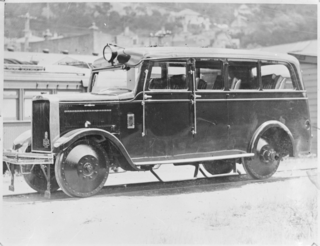
The Red Terror was a four-wheel railcar built in 1934 and used by the general manager of New Zealand Railways, Garnet Mackley, for six years for inspections of the railway system, and to demonstrate the potential for using petrol- and diesel-powered railcars in New Zealand. The railcar could carry 7 people plus the driver. It was given the classification RM 1.














